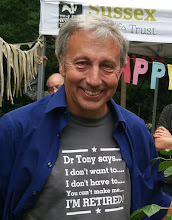On 20th October 2021 I gave a presenataion to the Sullington Windmills Womens Institute. I was given a very warm welcome so I thought I'd share a copy of a summary of that talk below:
We are now at a unique point in human history. Since about 1950 we have lived through a period often called The Great Acceleration; a period when many measures of human material wealth have increased exponentially. This accelerated period of economic development has been matched by an accelerated period of the impact of that development. So, for example, we see that as humans we have emitted more carbon dioxide since 1990 than we did in the entire history of the human race before 1990! That is the nature of exponential growth.
Another impact has been the degradation of nature, hence the need for the United Nation’s “Decade on Nature Restoration”. The World Wide Fund for Nature has estimated that since 1970 populations of vertebrate species (such as mammals, birds and reptiles) have decreased by 68%. Common species have become uncommon and extinction rates have increased. We are now in the earth’s 6th mass extinction event.
But does this matter? To illustrate this, we can look at the evolution of life on the planet. Before life evolved, our atmosphere was about 95% carbon dioxide. Oxygen in the atmosphere only appeared after about 2 billion years, but since then we can truly describe earth as a living planet; the chemical and physical make-up of the air, sea, soil, water and indeed geology is now largely determined by life itself. Humans have only been around for a tiny fraction of this time, yet our impact has challenged the very life support systems on which we all depend. Before the industrial revolution, our atmosphere has remained stable at around 0.03% carbon dioxide, not 95% (it is now over 0.04%).
The great whales give a good illustration of the part nature plays in maintaining earth systems. Whales eat deep in the ocean, but they defecate at the surface. This provides ideal fertiliser for marine algae which then grow and multiply, absorbing carbon dioxide from the air through photosynthesis. This carbon is then locked up, eventually sinking to the bottom of the ocean. Whales are effectively a carbon pump, taking carbon from the air and depositing it deep into the ocean, helping to maintain the low concentration of carbon dioxide in the air. This is just one example of “earth systems” that nature maintains, so keeping the planet liveable for all life including humans.
The great whales are, however, an example of how real values are not reflected in our economy. Our economy is flawed because of the poor way it attributes value to things that are vital to us. Many economists now say that we need to refocus our economic compass so we can properly value those things on which we ultimately depend.
The need to reverse our current trend of nature erosion is the driving force behind the UN’s Decade on Ecosystem Restoration. This requires the massive upscaling of efforts that breathe new life into our degraded ecosystems. We can pick this up at the local level with nature restoration on our doorstep, in our communities and in our Districts. A good example is the “Nature Recovery Network” map that has been published by Horsham District Council in partnership with the Sussex Wildlife Trust. This is a vision of a connected environment where we see better spaces for nature that are bigger, there are more of them, and they are joined up so nature can move around and be more resilient. Hence “better, bigger, more and joined”, from Prof Lawton’s 2010 Review “Making Space for Nature”, are still our guiding principles. In that way communities can support the places where we live and give us the higher purpose of restoring nature on which we all depend.

